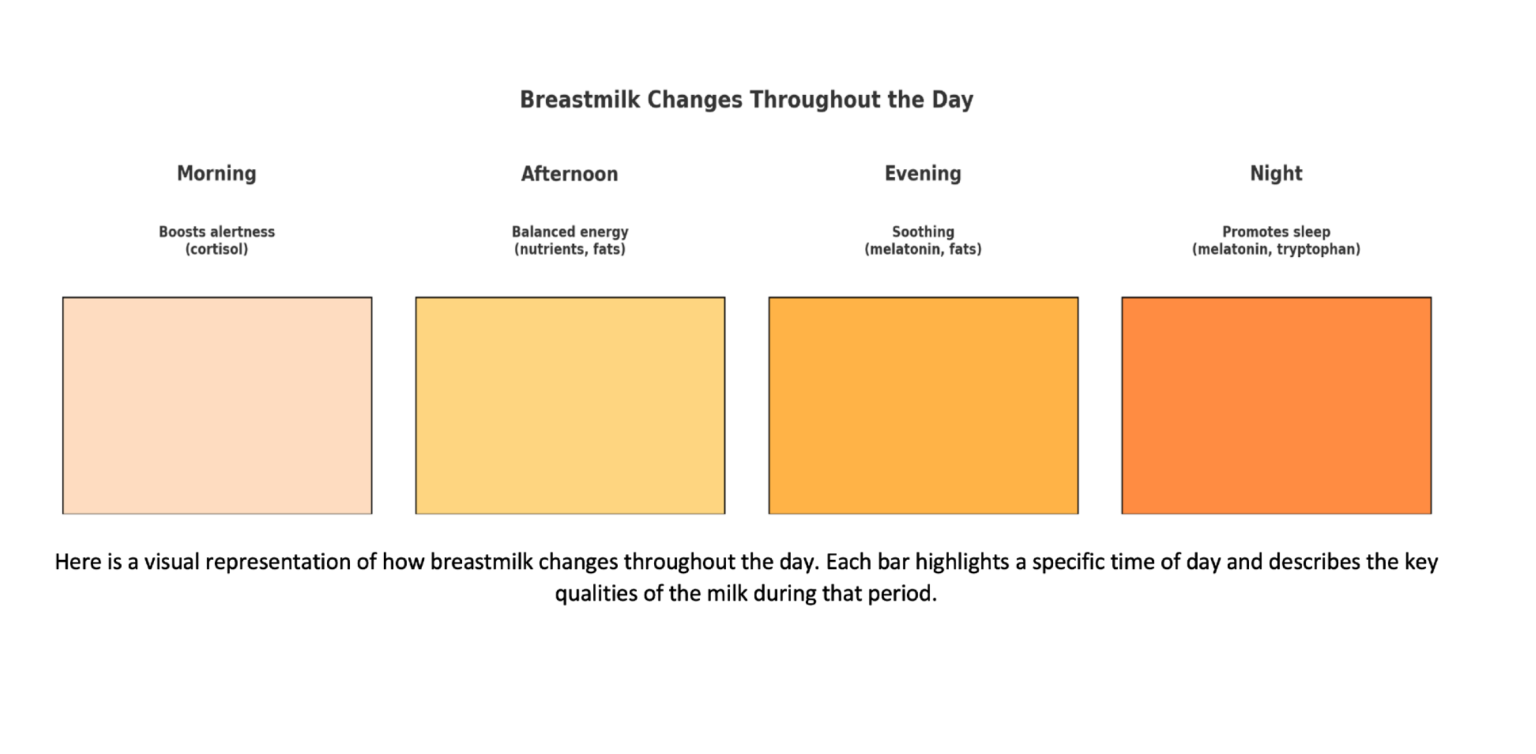As a new mom, you’re probably hearing a lot about the wonders of breastmilk, and for good reason! Breastmilk is often called “liquid gold” because of its incredible ability to adapt and meet your baby’s unique needs. One fascinating aspect is how breastmilk time of day affects its composition. Learning about these natural shifts can help you make the most of your breastfeeding journey.
Morning Milk: A Wake-Up Call
In the morning, breastmilk tends to have higher levels of cortisol, a hormone that helps regulate alertness. This is nature’s way of giving your baby a little boost to start the day. Morning milk is often lighter in texture and may look a bit waterier, but rest assured, it’s packed with everything your baby needs to wake up and feel energized.
When you understand breastmilk time of day patterns, you can see why your baby might seem more alert and active after morning feedings. Your body is working in perfect sync with your baby’s natural rhythms.
Afternoon Milk: Steady and Nourishing
As the day progresses, your breastmilk shifts to meet your baby’s midday needs. It tends to have a balance of nutrients and fats, helping keep your baby full and content. If your little one takes longer naps during this time, it might be because afternoon milk is designed to sustain them for these restful periods.
This is another beautiful example of breastmilk time of day variations matching exactly what your baby needs during different parts of their day.
Evening Milk: The Comforter
In the evening, breastmilk takes on a soothing quality. It often contains higher levels of melatonin, a hormone that promotes sleep. The fat content also increases, helping your baby feel full and relaxed. This is why evening feeds can be especially helpful for calming your baby during the fussy hours before bedtime.
Understanding breastmilk time of day helps explain why your baby might settle more easily after evening feedings. Your body is naturally preparing them for nighttime rest.
Night Milk: A Sleepy-Time Mix
Breastmilk produced at night is like a lullaby in liquid form. It’s rich in sleep-inducing hormones like melatonin and tryptophan, which help regulate your baby’s circadian rhythm (their internal clock). Night milk is designed to help both you and your baby rest, reinforcing the natural sleep-wake cycle.
This nighttime shift in breastmilk time of day is one of nature’s most clever designs, working to help everyone in your household get better rest.
Breastmilk Time of Day: Visual Breast Milk Changes 
Why Does Breastmilk Time of Day Matter?
Your body creates these changes as part of an intricate communication system with your baby. While breastmilk is always nutritious, the timing of your feeds can support your baby’s natural rhythms. For example, feeding expressed milk from the evening or night during the daytime might not be as effective in promoting wakefulness.
If you’re pumping and storing milk, consider labeling the time of day it was pumped to align your baby’s needs with these natural shifts in breastmilk time of day.
Trusting God’s Perfect Design
Breastfeeding is part of God’s perfect design for nourishing your baby. The way breastmilk time of day adapts to your baby’s needs is a beautiful testament to how wonderfully you were created. While these tips about timing can be helpful, remember they’re meant to guide you, not cause worry or stress.
The most important thing is to stay present in the moment and find joy in your breastfeeding journey. When you’re relaxed and at peace, your body naturally shifts into a rest-and-digest state, which allows it to do exactly what it needs to do. Stress and worry work against this natural process, so be gentle with yourself. You’re doing your best for your baby, and that’s exactly what they need.
Trust that God designed your body to nourish your child perfectly. These details about breastmilk time of day are fascinating, but they shouldn’t become another source of pressure. Simply feed your baby with love, and trust the process.
Breastmilk Time of Day: Tips for New Moms
Trust Your Body: Your milk is tailored to your baby’s needs at every stage of the day. Understanding breastmilk time of day can help you trust this natural process.
Follow Your Baby’s Cues: They may naturally prefer more frequent feeds at certain times, which aligns perfectly with natural variations.
Label Pumped Milk: If you’re storing milk, mark it with the time it was expressed for optimal use. This helps you take advantage of breastmilk time of day differences.
Prioritize Rest: Night feeds can be exhausting, but the natural sleep-inducing qualities of night milk can help both you and your baby settle back to sleep more easily.
Be Flexible: While understanding these patterns is helpful, don’t stress if your feeding schedule doesn’t align perfectly. Your baby’s needs and your lifestyle matter most.
Making the Most of This Knowledge
Now that you know about breastmilk time of day, you might feel more confident about your breastfeeding routine. This knowledge can be especially helpful if you’re:
Pumping at work: Try to pump at similar times each day to maintain consistency.
Building a freezer stash: Label your milk by time of day so caregivers can offer the most appropriate milk for different times.
Troubleshooting sleep issues: Consider whether offering evening or night milk during appropriate times might help support better sleep patterns.
Exclusively pumping: Understanding these changes can help you plan your pumping schedule to best support your baby’s needs.
Celebrate the Magic of Breastfeeding
The way your milk adapts to your baby’s needs is a testament to the amazing power of your body. Whether you’re exclusively breastfeeding, pumping, or supplementing, knowing about breastmilk time of day can help you feel confident and supported in your journey.
Motherhood is full of surprises, and breastmilk time of day is just one of them. Your body is doing something truly remarkable, adjusting its composition hour by hour to give your baby exactly what they need.
You’re doing an incredible job. Keep trusting your body, following your baby’s cues, and remembering that every feeding is giving your little one something perfectly designed just for them. The fact that you’re learning about breastmilk time of day shows how dedicated you are to understanding and supporting your baby’s needs.
Want more support on your feeding journey? Check out our guide on “Baby Hunger Cues: How to Know When Baby Is Hungry or Full” to better understand your baby’s feeding signals, or explore “Newborn Feeding Guide: Complete Guide for Parents”.
Want more fourth trimester support ? Check out our guide on “Newborn Care Tips for Parents: First 8 Weeks Guide” for comprehensive support during those early weeks.
– Ali









